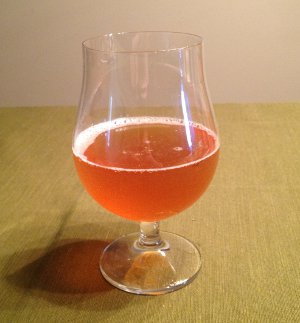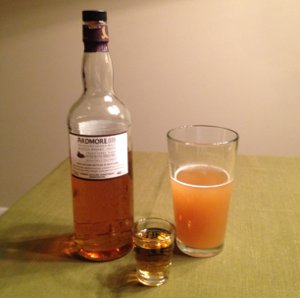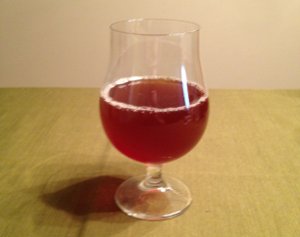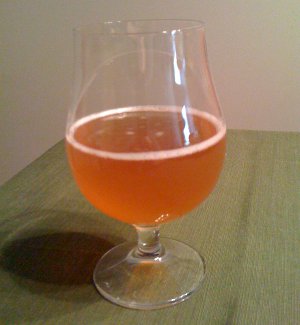So the past three beers I’ve brewed have been pale in color, and I was looking to do something a bit darker this time around. For one thing, dark beers are apparently more suitable for extract homebrew as the extract process naturally makes the malt a bit darker, and the fact that I’m doing a partial boil (I only really boil about 3-3.5 gallons of liquid, then add water later to make up the difference) also leads to a darker color. And after a summer of drinking hefeweizens, saisons, tripels, and other pale ales, I’m getting to be in the mood for something darker anyway. Stouts have never been one of my favorite styles, but I have to admit that certain variations on the style have really grown on me. One of the big advantages of doing homebrew is that you can make whatever you want, so I started trying to figure out how to make a stout that emphasized the chocolate and caramel flavors, rather than the one–dimensional roastiness that overpowers a lot of stouts. I didn’t want a really dry stout, nor did I want a super-strong imperial stout. Something in the middle, with a lot of body and caramel/chocolate sweetness, but not a ton of roastiness.
I toyed with the notion of a milk stout, but none of the homebrew kits I could find online were really doing it for me. So I started playing with some online recipe calculators, and came up with a (rather lame) recipe. I probably know a lot more about beer than your typical beer drinker, but when it comes to expert homebrewer stuff, I’m still somewhat of a newb. I was unsure of my recipe, so I figured I should just take it to the local homebrew shop and ask the friendly guys there what I should do. I’m not entirely convinced that the recipe we ended up creating is exactly what I want, but it feels like it will be good.
Brew #5 – Stout
August 13, 2011
0.5 lb. Roasted Barley (Specialty Grain)
0.75 lb. British Chocolate Malt (Specialty Grain)
0.25 lb. Belgian Special B (Specialty Grain)
0.5 lb American Crystal 120L (Specialty Grain)
7 lb. Light DME
1 oz. Target Hops (bittering @ 8.6% AA)
Wyeast 1284 – Irish Ale Yeast
If you’re in the know, the first thing you’ll notice is that the majority of the sugars in this beer consist of light dry malt extract. But stouts are supposed to be dark! Well, it turns out that you don’t need much in the way of dark, roasted malts to get that nice, dark brown/black color, and since the specialty grains were fresh (and just crushed), you can get a much better flavor out of that than you can by just selecting dark malt extracts. As such, I think this is the most complex (and largest) specialty grain bill I’ve brewed. And according to our calculations, it will indeed be very dark. The way brewers measure beer color is called the Standard Reference Method (SRM), and this beer should have an SRM of around 45 (anything above 30 is usually referred to as black).
The other thing that stands out about the recipe is the single, relatively-small hop addition. Most brews have a hop schedule consisting of three additions: one for bittering, one for taste, and one for aroma. But since I was looking to highlight the caramel, chocolate, and roasty flavors of my malts, those taste and aroma hops would only detract from the experience. As such, the homebrew shop guy recommended I go with a single hop addition at the beginning of the boil. I’m not entirely convinced that there’s enough bitterness in what I ended up with, but again, I’m looking to make something that is sweet, chocolately/caramelly, and a little roasty. This isnt’ meant to be a hop bomb like some imperial stouts (or American Black Ales, or whatever you call that style), so it makes sense that the hop presence would be a bit muted.
I steeped the specialty grains in approximately 2.5 gallons of water at around 150° F – 160° F for about 20 minutes. Sparged with some 150° F water, bringing the total volume of the pot up to a little more than 3 gallons. Let the grains drain out (careful not to squeeze the grain bag), observed the black-as-night color of the wort and the various aromas it gave off. This may end up being a bit roastier than I expected, but nothing I could do about it at that point, so I punched up the stovetop to bring the mixture to a boil. Once at the boil, added the 7 pounds of DME and the hops and boy did it create a lot of bubbly head (Not sure exactly if you would call this head, but there was a bubbly head-like substance at the top of the pot, and it took some supervision to make sure it didn’t boil over). Settled in for the 60 minute boil. Once complete, I moved the pot to the ice bath in my sink. Unlike previous attempts, I came prepared with lots of ice this time, and that certainly helped cool the word down quicker… until all the ice melted. Still, it got down to around 100° F quicker than any of my previous attempts. At this point, I strained the wort into my fermenter and topped it all off with cold water, bringing the temperature down to around 75° F. Just a hint too hot, so I let it sit for a while (once I hit the cooling phase, I cranked the air conditioner, hoping to help with the cooling process), took my hydrometer reading, and pitched the yeast.
If I got one thing right with my initial recipe, it was the yeast choice (or at least, my yeast choice was exactly what the homebrew store guy said I should use). Apparently Irish Ale Yeast is really well matched with dark malts. So before I even started brewing, I had activated the wyeast smack-pack. It was dated 5/16/11, which is still somewhat recent, but unlike previous smack-packs, it didn’t swell up right away and took some cajoling to get it to swell at all. About 4 hours after the initial smack, it seemed to be swelling a bit, but I’m not sure if this yeast was really ready. This represents my greatest fear in this batch – the yeast seems to be a bit old and tired. Now, the Wyeast package says that the swelling need not be extreme for the yeast to be ok, but I’m still a bit worried (note to self – learn how to make a yeast starter so that I can avoid such anxiety). I pitched it at around 70° F, so I guess we’ll see how it does.
Original Gravity: 1.062 (approximate). Adjusting for temperature, maybe a tad higher. Either way, this is a little lower than my recipe implied (somewhere around 1.067), but still within the realm of what I wanted to make. Assuming solid attenuation, I’m looking at an ABV of around 6-6.5%, maybe higher.
My last batch turned out really well, so I’ve got high hopes for this. Even if it comes out a little roastier than expected, I’ll be happy. I am a bit worried about the yeast, but I saw some activity in the airlock this morning, so that’s promising. And besides, I worried a lot about the last batch, and it turned out great (first batch I’ve made that I really love).
Not sure what’s up next. I think I’ll want to get the Belgian Dubbel underway, so that I have it ready for the Holidays. After that, who knows? I was thinking about an IPA of some kind, but there are definite issues with hop utilization in extract boils, so maybe I’ll hold off on that a bit. I probably won’t be able to get to the next batch until October anyway, so I’ve got some time.
(Cross posted on Kaedrin Beer Blog)





